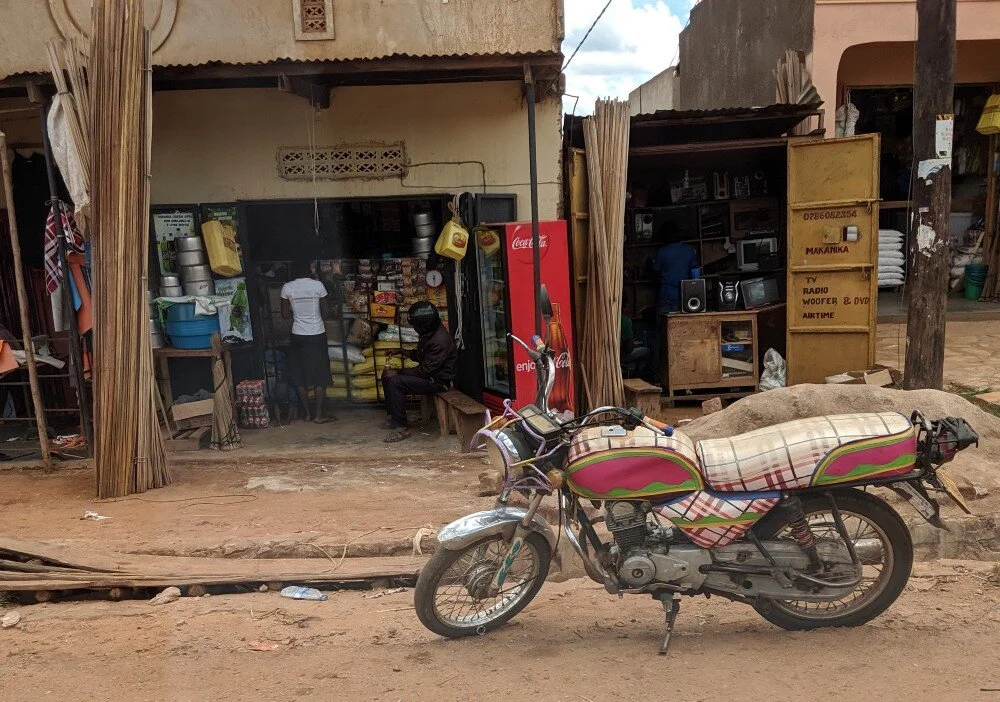Photo essay: Motorcycles of Uganda
Consider the humble motorcycle. Commonly known in East Africa as a “boda-boda” (the vibrating sound of a poorly muffled two-stroke engine) they have become ubiquitous across the continent over the past decade, thanks to their durability and affordability. A used 100cc or 150cc Bajaj Boxer can be had for as little as 1 to 2 million Ugandan shillings ($250–500 US); well within reach for much of Africa’s rapidly growing population.
In late 2019 I spent a week jet-setting (van-setting?) around Uganda in a minibus full of people and suitcases, spending up to 12 hours at a time watching the landscape roll by as we bounced from city to city and appointment to appointment. With little else to occupy my time, I started to take note of the ubiquitous Boxer motorcycles that flowed along the roads with us.
In Uganda it’s expected that you’ll get your bike fitted with custom upholstery to make it easier to recognize, and to reflect your own personal style.
Many years before, my friend Leeman did something similar to his Honda CX-500, covering the gas tank with bright red faux Muppet fur, so I started snapping pictures of some of the more interesting motorcycles, and sending him the photos via WhatsApp. In the process I discovered that my phone’s camera setup (Pixel II) was surprisingly good at capturing these images.
Over the next few days I took hundreds of motorcycle photos as we traveled, focusing on everyday street scenes in an endeavor to, as Viktor Shklovsky said, “make the strange familiar and the familiar strange.”
The rapid rise of the motorcycle across SubSaharan Africa over the past decade has had dramatic and far-reaching socioeconomic consequences. They contribute to urban congestion and pollution, and many African governments see them correlated with black and grey-market activity. Citing crime, terrorism, and deadly accidents, countries like Ethiopia, Nigeria, Burundi, and Rwanda have attempted to institute full or partial bans on two-wheeled motor vehicles within their major cities.
But the boda-bodas are also an incredibly powerful engine of commerce. Farmers who previously had limited market access can now sell their goods in bulk much more broadly and workers from farther afield can access employment opportunities more readily.
Unlike the US, where motorcycles are primarily a recreation item, Africa’s motorcycles are an economic linchpin and a springboard to opportunity.
Furthermore, public transit infrastructure is sorely lacking across much of the continent, and even private transport options are inadequate. Motorcycle taxi services are struggling to answer the demand, and app-based taxi services like Uber and Bird now include very affordable motorcycle taxi options (Uber’s moto drivers are usually required to make a helmet available to their riders, but you may want to bring your own). Kampala, in particular, has a reputation as the motorcycle capital of Africa, and recently even inspired a successful South African movie about the dangerous life of a young motorcycle taxi driver: “The Boda Boda Thieves.”
As an outside observer, the motorcycle provides me with a useful focal point. I’ve never lived in Uganda or any other African country for more than a couple of weeks at a time, and so many of the dynamics of day to day life contain nuance and complexities that breeze past my attempts at perception.
By looking at a single familiar thing, like a motorcycle, I can begin to develop a frame of reference for broader understanding.
Thanks to the speed and resolution of my phone’s camera setup, its relatively innocuous size, and the mind-boggling volume and cheapness of data storage, my process is a simple one: I cup the phone in my hand and snap as fast as I can whenever I see an interesting motorcycle.
Thanks to the speed and resolution of my phone’s camera setup, its relatively innocuous size, and the mind-boggling volume and cheapness of data storage, my process is a simple one: I cup the phone in my hand and snap as fast as I can whenever I see an interesting motorcycle.
As I sort through the pictures, the street scenes emerge in rich layers.
A multitude of stories in every image; I see more each time I look.
I’ve tried this approach in the US, but my eyes don’t work the same at home.
“In a car you’re always in a compartment, and because you’re used to it you don’t realize that through that car window everything you see is just more TV. You’re a passive observer and it is all moving by you boringly in a frame.
On a cycle the frame is gone. You’re completely in contact with it all. You’re in the scene, not just watching it anymore, and the sense of presence is overwhelming.”
-Robert Pirsig
















